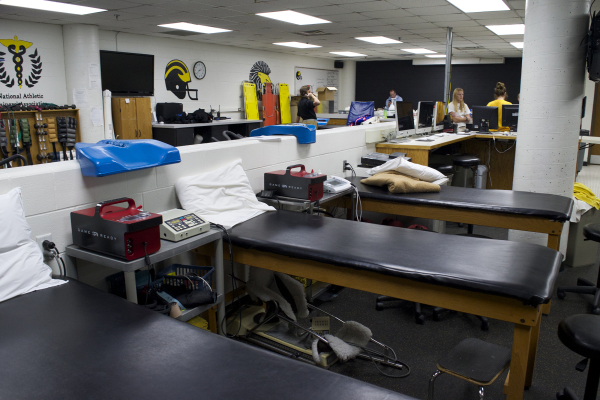The Athletic Training Program at Gustavus is established for students who want to prepare for a career as an athletic trainer and is endorsed by the Commission on Accreditation of Athletic Training Education (CAATE).
Athletic trainers are medical professionals who work with other healthcare providers to prevent, diagnose, treat, and rehabilitate injuries. The Gustavus athletic trainers and the athletic training students provide emergency care at athletic practices, games, and meets; evaluate injuries, make referrals, provide rehabilitation plans, and teach injury prevention to student athletes.
The athletic trainers can be found in Lund Center in the Athletic Training Room. There are many practices that the athletic trainers exercise in order to take care of student athletes. One student athletic trainer is Junior Ben Bonser.
“For preventative measures we know how to tape, brace, assign pre-habilitation programs and wound care. We also have access to a lot of different modalities such as an electrical stimulation machine, ultrasound, or even just icing. All of what we do is patient specific so we really strive to see what our patients’ goals are before we start treatment. Once we know what they have in mind and what they want out of the time in the ATR we can choose our method of treatment be it long term or short term,” Bonser said.
First-year student athlete Mae Grigsby visited the ATR with a foot injury. “The professional athletic trainers and the student athletic trainers collaborated really well to figure out what was going on. They referred me to the hospital, but still kept checking in with me to see how my foot was doing. I could tell that they really cared about making me feel better,” Grigsby said.
Unfortunately, the athletic trainers can only officially treat Gustavus student athletes at this time. The program targets athletes participating in sports, but with the changing times the term “athlete” is very vague. Trainers try to help anyone who comes through the doors, whether it be assessing them in the ATR or referring them elsewhere, like Health Services.
“Gustavus can only be liable for student athletes, and there are already so many athletes being treated by four athletic trainers, it would be impossible for them to manage the entire student body. Our program does recognize this, and, like all departments, would love to get funding to provide students with another athletic trainer,” Junior Athletic Trainer Sam Paripovich said.
“All of what we do is patient specific so we really strive to see what our patients’ goals are before we start treatment.”—Ben Bonser
Becoming an athletic trainer involves an application process with the program ideally beginning in the fall of one’s sophomore year. There are a few prerequisite classes that need to be taken, a paper for the application into the program, an interview with the clinical educators and the head athletic trainer.
“It’s definitely a nerve racking process but once you get through it and get in the program, it’s a pretty cool feeling of accomplishment,” Bonser said.
There are clinical requirements to complete once in the program, and practicals and competencies to pass in order to progress through the courses in the program. Trainers also have to maintain first aid and CPR certifications and keep a certain GPA.
The campus organization, Gustavus Athletic Training Association (GATA), is involved with the community and trainers are also a part of a few other athletic training associations in the Midwest such as the Minnesota Athletic Trainers Association (MATA) and Great Lakes Athletic Trainers Association (GLATA). These associations have regular symposiums that trainers go to in order to further their clinical education.
Gustavus is one of only six schools in Minnesota with an athletic training program. Earning a degree from a college with an accredited athletic training program is required to take the Board of Certification Exam, which has to be passed in order to become certified.
“Not only is the athletic training program here beneficial for the athletes, but also as a student, we are so lucky that our program prepares us so well for our careers after graduation. I plan on going onto physical therapy school after graduation, and I know that having so much patient experience and being exposed to so many injuries and how they’re managed will beyond prepare me for my next step,” Paripovich said.
-Emma Hunt
